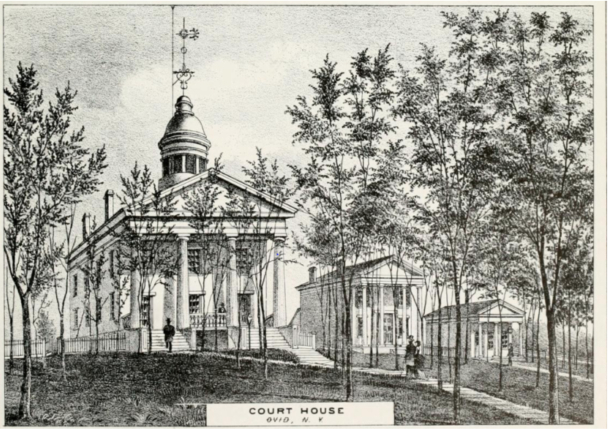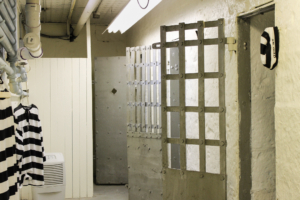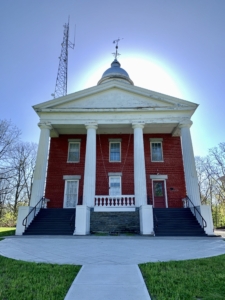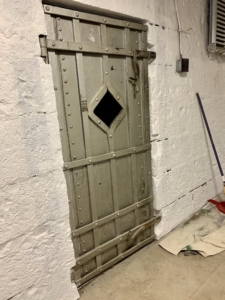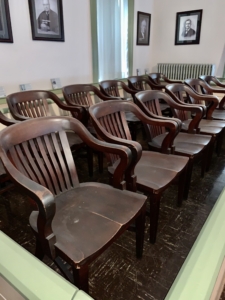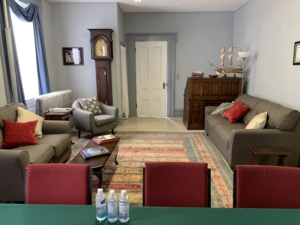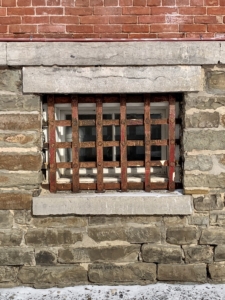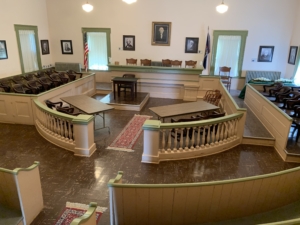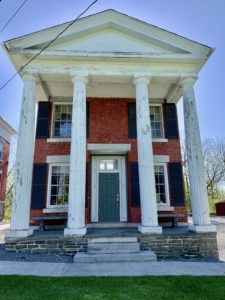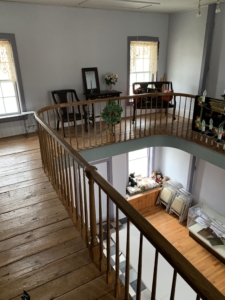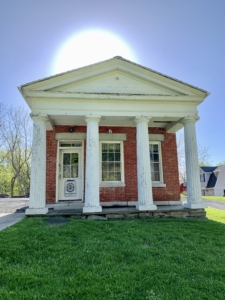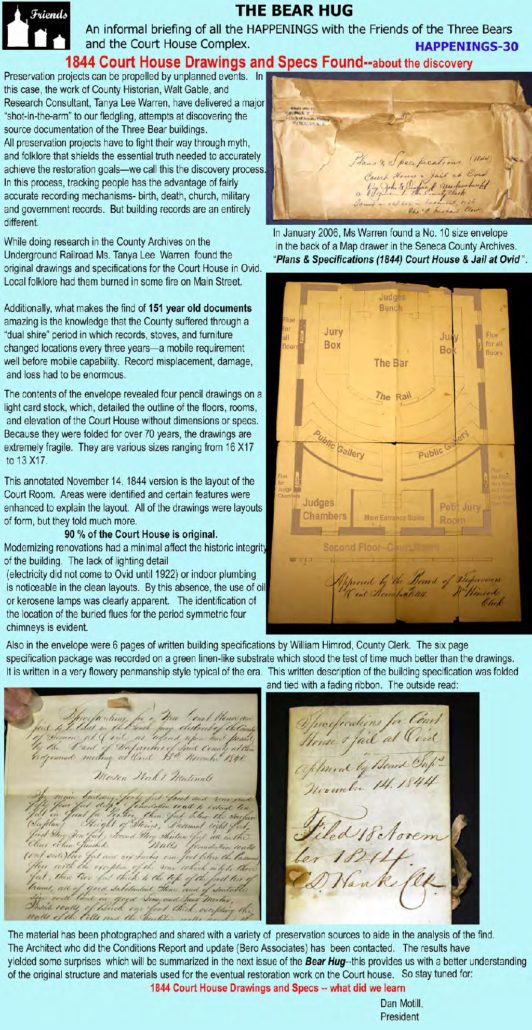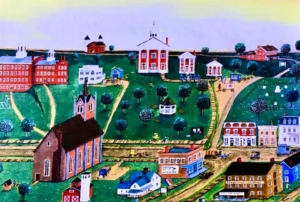History of the 3 buildings
The Three Bears
The half-shire (Dual county seat within one county) public buildings of Seneca County so pleasantly situated on a knoll fronting Court-House Square in the Village of Ovid—now commonly called “The Three Bears”—is one of the best-known historical landmarks in the scenic Finger Lakes region of New York State. The largest of the brick buildings—the Court-House—is called with affection “Papa Bear.”
Next south (i.e., the middle of the three buildings) comes the “Mama Bear” and next south is the smallest of the three—the “Baby Bear.” The Historic Preservation League of New York State indicates that these structures are unique in the entire United States—that there is no other set of three adjacent public buildings intact of the Greek revival style of architecture. That alone helps to explain why they are listed on the National Register of Historic Places.
The colloquial name of the Three Bears as used by the locals is lost to history. The three buildings are done in the Greek revival Style which has no connection to the popular children’s story. The appeal of ancient Greece rose in the 19th century along with the growing acceptance of democracy. This made Greek architecture suddenly more attractive as it symbolized the freedom of the Greeks.
In 1803, Jefferson appointed Benjamin Henry Latrobe as surveyor of public building, and Latrobe designed a number of important public buildings in Washington, D.C. and Philadelphia, including work on the United States Capitol and the Bank of Pennsylvania done in this style. Greek revival Architecture | HGTV
- Tall columns and pediments. The ancient Greek temple model, with its row of tall columns topped by a pediment, includes two of the most obvious characteristics
- Horizontal transom. It sits over the front door, instead of a fanlight like the earlier Federal period.
- Moldings. Bold but simple moldings, throughout the interior and exterior also exemplify the look of high-style Greek revival.
- Embellishment. Expensive homes might add more detail, like framed dormer windows on the second story, with pilasters and pediments.
The symmetry, dignity, and formality of the Greek revival style reflected the high regard in which law and local government were held. The Papa Bear courthouse is architecturally significant as an example of an intact mid-nineteenth-century courtroom. It possesses a high level of period architectural integrity and retains many of its original materials and features. As was typical for nineteenth-century courtroom architecture, the Ovid courtroom is graced with large windows (on three walls) and a tall ceiling. The judge’s bench, jury boxes, and witness chair were placed on elevated platforms so they could be seen clearly from anywhere in the courtroom. The seating in the courtroom was tiered and curved to allow for better viewing by the public
The Court-House was erected in 1845 as a replacement for the original wooden courthouse building which had deteriorated and became unsafe. The building contract was awarded to the brothers Obadiah B. Latham, Jr. and Oliver S. Latham of Seneca Falls. Obadiah was an architect and civil engineer. As was typical for nineteenth-century courthouse construction in New York, architects and builders were chosen for demonstrated competence and their work was carefully supervised by an appointed committee. For this construction project, the committee consisted of Elijah Denton, Dr. Claudius C. Coan, and Clement Jones. Clement Jones and Sidney Grant drew up the plans for the courthouse. Bricks for the courthouse and the Clerk’s Office (i.e., the Baby Bear) were produced locally at John B. Seeley’s farm. The use of local materials not only kept costs down but also served to benefit suppliers and builders in the area.
Walter Gable Seneca County Historian 2004 The Three Bears (seneca.ny.us)
Papa Bear
The largest of the three building was erected in 1845. The courthouse as erected in comprised of two stories and attic. With a substantial stone jail in the cellar. Its cupola contained a fine bell rung at the commencement of court sessions. The bell was manufactured at the works Cowing & Co. in Seneca Falls, NY. The whole width dome, being surmounted by a weathervane taken from the original structure. The first floor is made up of the grand jury room, sheriff’s residence. The courtroom is on the second or upper floor. Within its walls justice has been administered throughout the years, the guilty condemned to a just punishment and the innocent set free. In this room the Catholics, Episcopalians, and Baptists held services, also used for concerts and lectures and focused political meetings. This included temperance lectures in October 1854 by Honorable Benjamin Joy. Horace Greeley in September 30, 1857 then editor of the New York Tribune spoke to a packed audience in the courtroom. Prisoners were held in the jail cells below and awaited trial. Some of whom escaped causing great concern in Ovid.
The building fell in disrepair and required extensive work which was spear headed by the Friends of the Three Bears. During the COVID quarantine, volunteers painted and prepared the space for tours in 2021. Plans are underway to designate Papa Bear as the Cultural Center of Ovid.
Mama Bear
This first court proceedings was held in the home of John Seeley in the Village of Ovid until spring of 1808. Upon the organization of Seneca County on March 29, 1804, the capital was located in Verona Village on Military Lot 3 on the Ovid Town Line. Here on June 16, 1806 the day of the great eclipse the wooden framed first courthouse and jail in Seneca County was raised at the cost of $1,000. For the next forty years, the pioneer judges administered justice. The building was completed in 1808 and in May court was moved from Mr. Seeley’s home to the new building. The master carpenters on the building were the Montgomery brothers who resided in Lodi. A dreadful conflagration took place in the jail in 1817 but the building was rescued from the fire. The most notable Judge was Cornelius Humphrey during this period who was a Colonel in the Revolutionary, a member of the second continental Congress, a Representative from Duchess & Seneca County in the New York State Assembly.
On the greens, the Militia conducted exercises resplendent in their uniforms. Located in this park like setting was also the public whipping post and gallows. There was an execution of John Andrews who committed murder by clubbing a distillery worker over a pint of whiskey.
After much work by the Friends of the Bears, The Mama Bear is now the south Seneca County tourist center. You are welcome to stop in to learn about the other Bears, historical properties and Finger Lake attractions.
Baby Bear
Originally built in 1845 as a fireproof office building for the clerks office, the facilities quickly became too small for the county records therefore Mama Bear was built and was utilized as the new “Clerks Office.” Baby Bear was also once used as a temporary facility for a local bank after a disastrous fire destroyed most of the business portion of the village on October 13, 1874. Sometime later the Baby Bear was used virtually exclusively by the Grand Army of the Republic, the organization of Union veterans of the Civil War. As Civil War veterans passed away, the Sons of Union Veterans, Caywood Chapter, the successor organization of the local chapter of the G.A.R., has continued to use the Baby Bear exclusively. The building continues today as a small museum to the local Civil War Veterans. By special request, the museum can be seen. Please contact the Tourism Center in Mama Bear to set up an appointment.
Three Bears History by Walt Gable
Gracing the east end of the village park in Ovid are three buildings in Greek revival style. Local folk have referred to these buildings for years as the Papa Bear (the largest one), the Mama Bear (the middle one) and the Baby Bear (the smallest one).
According to the Preservation League of New York State, these three brick structures are unique in the entire United States as the only set of three intact adjacent public buildings in Greek revival style architecture. For several years, these buildings housed Seneca County offices when they were in Ovid. Seneca County was a half-shire county, with the county seat alternating between Waterloo and Ovid every three years.
The Papa Bear and the Baby Bear were constructed in 1845. The Seneca County Board of Supervisors decided there was a need to replace the deteriorating wooden courthouse in Ovid and a new courthouse building (which became known as the Papa Bear) was built on the north side of the old wooden courthouse. A new county clerk’s office building (which became known as the Baby Bear) was built on the south side of the old courthouse. The contractors were the Latham Brothers of Seneca Falls. Bricks were produced locally on the John B. Seeley farm.
These two new buildings were built in the popular Greek revival style, dominant from the 1830s to the 1850s and used for houses, schools, churches, commercial buildings, courthouses and other government buildings. The popularity of the Greek revival style in the United States was partly due to its symbolic association with the democratic ideals of ancient Greece. The symmetry, dignity and formality of this style reflected the high regard in which law and local government were held. These three structures have the basic temple design with a portico of graceful Doric columns.
The Papa Bear courthouse is architecturally significant as an example of an intact mid-19th century courtroom. It possesses a high level of period architectural integrity and retains many of its original materials and features. As was typical for 19th century courtroom architecture, the Ovid courtroom is graced with large windows (on three walls) and a tall ceiling. The judge’s bench, jury boxes and witness chair were placed on elevated platforms so they could be seen clearly from anywhere in the courtroom. The seating was tiered and curved to allow for better viewing by the public.
Like its predecessor, the new courthouse was not only the setting for court trials and political debate but also for concerts, lectures and meetings of community organizations. One of the most celebrated speakers to give a lecture in the courthouse was Horace Greeley, editor of The New York Tribune, who spoke there on Sept. 30, 1857.
In 1859 it was decided a larger county clerk’s building was needed. This new building — known as the Mama Bear — was built in between the two brick buildings, on the site of the old wooden courthouse.
A number of changes in use have taken place at the Three Bears throughout the years. The Papa Bear ceased to be the site of court sessions sometime before 1975. This was largely because the courtroom is not handicapped accessible.
Each year, the Seneca County Board of Supervisors still holds one of its monthly meetings in the Ovid courtroom. For many years the Papa Bear provided living quarters for the sheriff or undersheriff. From 1905 until 1962, the Mama Bear housed the Ovid Free Library. In 1962 the Mama Bear housed the Seneca County Department of Health until that office moved to the Papa Bear in 1974. The Mama Bear then became a satellite office for the Seneca County Sheriff’s Department.
The Baby Bear housed the county surrogate’s office from 1862 until about 1874 in those alternating three-year terms that the county clerk was based in Waterloo. Sometime later the Baby Bear was used exclusively by the Grand Army of the Republic, the organization of Union veterans of the Civil War. As Civil War veterans passed away, the Caywood chapter of the Sons of Union Veterans succeeded the local G.A.R. chapter.
In recent years Seneca County government has moved away from using the Three Bears, except when the county board of supervisors holds one of its meetings in the old courthouse. Fortunately, since 2002 the Friends of the Three Bears group has spearheaded efforts to maintain the buildings and use them for tourism promotion of local history and other beneficial economic uses.
Reference: “Way Back when in Seneca County: Ovid’s three historic Bears still going strong.” Walter Gable, Seneca County Historian: January 29, 2016 Finger Lakes Times

